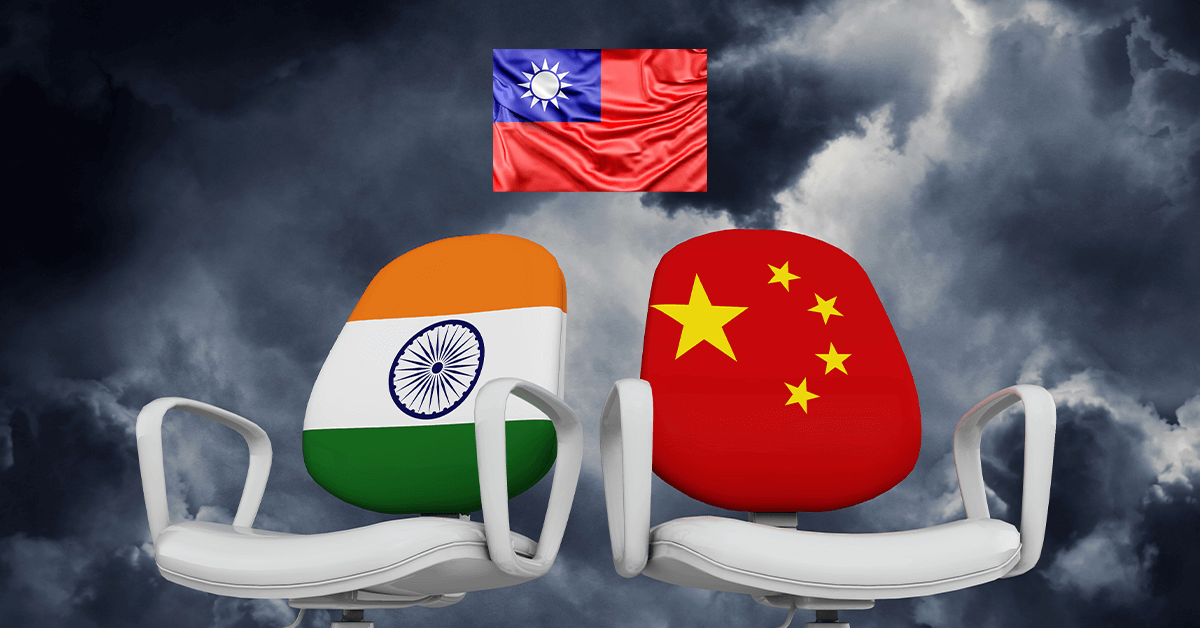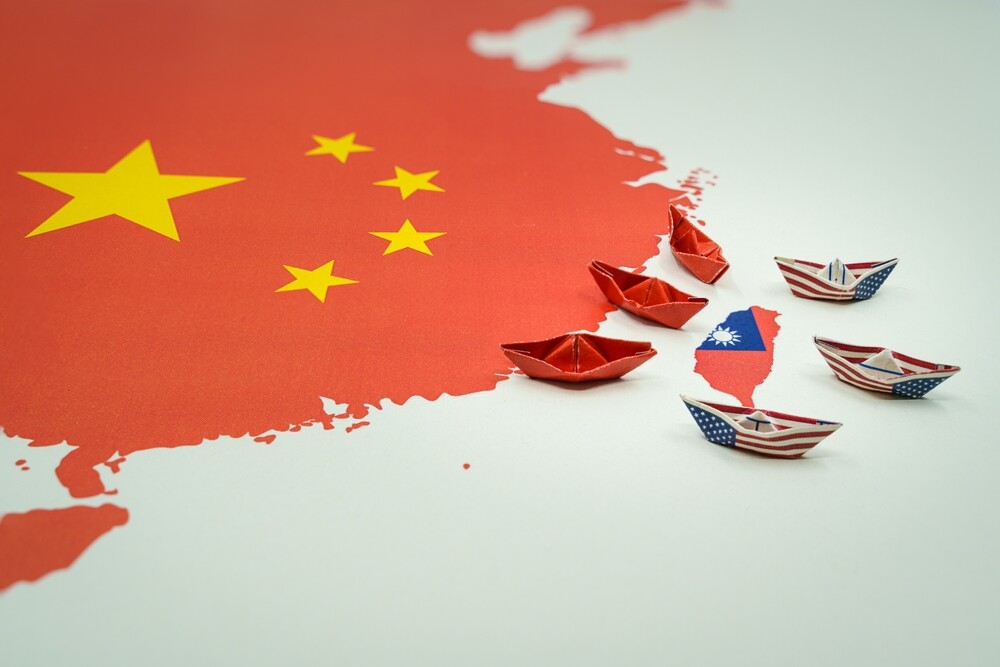India Under Modi’s Inching Footsteps Towards Taiwan As China Looks On At The Evolving New Dynamics In The Indo-Pacific
In recent years, the geopolitical dynamics in the Indo-Pacific region have witnessed significant shifts, with India and Taiwan experiencing an evolving relationship against the backdrop of changing global dynamics. The growing alliance between New Delhi and Taipei - from economic collaborations to cautious diplomatic manoeuvres, the two nations find themselves at the intersection of regional complexities. Examining this relationship becomes particularly crucial in the context of India's delicate balancing act, managing ties with Taiwan and its formidable neighbour, China.

Under Narendra Modi’s leadership, India is cautiously advancing its engagement with Taiwan.
The economic collaboration between the two nations in trade, investment, and industry has flourished, with bilateral trade reaching nearly $7.7 billion in 2021, a remarkable increase from the $1.19 billion recorded in 2001.
Several significant agreements underline the strengthening relationship between India and Taiwan, including the Bilateral Investment Agreement (BIA) initiated in 2002, which came into effect in 2005. An updated version was signed in 2018, aiming to safeguard Taiwanese investments and the rights of Taiwanese investors in India.
Additionally, agreements such as the AEO Mutual Recognition Agreement, Customs mutual assistance agreement, and ATA Carnet have been solidifying the cooperative foundation.
Initially cautious about overt displays of support for Taiwan, the Modi-led Indian government refrained from sending official representatives or lawmakers to the inauguration of Taiwan’s first woman president, Tsai Ing-wen, in 2016.
However, a shift occurred in 2020 when, after Tsai’s re-election, two Indian lawmakers were virtually dispatched to convey congratulatory messages during her oath-taking ceremony.
Bilateral trade increased substantially from just over $1 billion in 2001 to $7 billion in 2021. A notable development was the opening of a third Taipei Economic and Cultural Centre in Mumbai in July, functioning as a de facto consulate for Taiwan.
This expansion signifies the evolving dynamics and growing significance of the India-Taiwan relationship amid the backdrop of regional complexities.

The Flourishing Ties
Recently, Foxconn, based in Taiwan and a key electronics components supplier for Apple, declared investments totalling $1.6 billion to reduce its dependence on mainland China. Simultaneously, the Indian government has actively encouraged Taiwan Semiconductor Manufacturing Company (TSMC), a leading semiconductor firm, to establish a fabrication plant in India.
Beyond economic ties, discussions are underway for a labour agreement between the two nations.
Taiwan’s labour minister confirmed ongoing talks for a pact that would allow Indian nationals to migrate to Taiwan for employment, though the exact number of workers permitted remains uncertain.
In November, Taiwan’s deputy education minister led a delegation to various Indian universities, stressing a commitment to bolstering educational collaboration, as stated in a Taiwanese government press release.

China’s Growing Unease
The collaboration has extended to defence matters, causing displeasure in Beijing – In August, three former high-ranking Indian military officials participated in a security dialogue hosted by Taiwanese authorities in Taipei.
While the delegation labelled it a “private” visit, reports hinted at “closed-door talks” with the Institute of National Defence and Security Research, a think tank under Taiwan’s defence ministry.
The key moment leading to the current tensions between India and China occurred in June 2020 during a clash between their military personnel along the disputed border; the skirmish resulted in the deaths of at least 20 Indian and four Chinese soldiers, prompting a significant shift in India’s China policy.
According to Suvam Pal, a Taiwan-based Indian journalist, any previous warmth in relations, exemplified by Modi’s 2018 visit to Wuhan and Xi’s subsequent visit to India, gave way to a trust deficit and cold-shouldering.
The fallout in 2020 solidified India’s engagement with Taiwan, marked by the complete relocation of its foreign service officers’ Chinese-language training from mainland China to Taiwan.
Jabin Jacob of India’s Shiv Nadar University observed that the relationship between New Delhi and Taipei has logically progressed from common economic interests to political and strategic considerations. With Taiwanese companies diversifying away from China and China increasing pressure on both the Indian border and Taiwan, the natural alignment of India and Taiwan is expected to grow.

Also, it has been a recurring error on the part of Beijing to assume that Indian policies are tethered to or reliant on American policies, according to observations.
India officially recognized the People’s Republic of China and adopted its one-China policy in 1950, almost three decades before the United States did and throughout the Cold War, New Delhi maintained no official ties with Taiwan.
The “Look East” policy, initiated by India in 1991 following the dissolution of the Soviet Union, aimed at cultivating economic and strategic relations with neighbouring nations.
The policy sought to elevate India’s regional power status to counterbalance China’s expanding influence; as a result, over time, representative offices were established in each other’s capitals by New Delhi and Taipei.
The subsequent years were described as an “exploratory phase,” during which New Delhi cautiously navigated its relationship with Beijing and remained sensitive to China’s one-China policy, as noted by Jeff Smith of the Heritage Foundation.
However, by the early 2010s, India’s deferential stance towards China began to erode as bilateral ties became more contentious, marked by mini-crises and a more assertive China under Chairman Xi Jinping.
Despite the perception that Taiwan’s diplomatic space was contracting, with only a handful of countries recognizing it as a sovereign state, India emerged as a key player in enhancing diplomatic and economic linkages.
Connections between India and Taiwan were likely facilitated by Prime Minister Modi’s prior engagements with Taiwan, dating back to 1999 when he visited the island as the general secretary of the Bharatiya Janata Party.
Subsequently, in 2011, as the chief minister of Gujarat, Modi hosted a Taiwanese delegation, and the following year, officials from Taiwan participated in a global conference in Gujarat aimed at attracting foreign investment.
However, after the high-profile Xi-Modi meetings in 2018 and 2019, the Indian government adopted a more cautious approach towards Taiwan because of its burgeoning trade and commerce ties with Beijing, New Delhi refrained from jeopardizing its rapport with China.
Modi’s second swearing-in ceremony in 2019, following the BJP’s resounding victory, did not extend an invitation to Taiwan’s representative.
However, a significant shift occurred in 2020 after the deadly clash between Indian and Chinese soldiers in Ladakh, escalating tensions along the extensive border.
The Ladakh incident led to an accumulation of troops on both sides, and despite 28 rounds of diplomatic talks, no breakthrough has been achieved to ease the dispute. As Sino-Indian relations soured, Taipei found itself benefiting from New Delhi’s rekindled warmth.
In August of the same year, when then-US House Speaker Nancy Pelosi visited Taiwan against China’s objections, India called for “restraint” amidst Beijing’s military exercises around the island. Notably, New Delhi refrained from mentioning the one-China policy in its statements—a departure from previous diplomatic caution.
Since 2010, amid Beijing’s claims on the Indian-administered state of Arunachal Pradesh, New Delhi has avoided explicitly endorsing the one-China principle. In 2014, then-Indian Foreign Minister Sushma Swaraj conveyed to Beijing that for India to accept a one-China policy, China should reciprocate with a one-India policy.

While India has shed its “old reticence” regarding Taiwan, Harsh Pant of King’s College London suggests that its stance on the one-China policy is unlikely to undergo a fundamental change. However, there’s a growing sentiment that the time is ripe for New Delhi to increase its political engagement with Taiwan.
Sana Hashmi of the Taiwan-Asia Exchange Foundation noted in a recent op-ed that India stands as a “notable exception” globally for not sending or encouraging a parliamentary delegation to Taiwan.
She emphasized that despite the pandemic easing and increased visits to Taiwan by lawmakers from other countries, only one Indian lawmaker had visited the island in the past two years.
The Last Bit, India’s engagement with Taiwan has become a critical facet of its foreign policy, shaped by economic interests, strategic considerations, and the changing dynamics in the Indo-Pacific.
While New Delhi maintains a cautious stance on the one-China policy, there is a growing sentiment that the time is ripe for India to deepen its political engagement with Taiwan.
The evolving relationship between these two nations not only reflects the geopolitical intricacies of the region but also stresses the need for like-minded countries to collaborate and navigate the shifting realities of the Indo-Pacific.
As diplomatic dialogues persist and economic ties strengthen, the India-Taiwan relationship is indicative of the delicate balance India must strike in pursuit of its interests amid complex regional dynamics with China.




